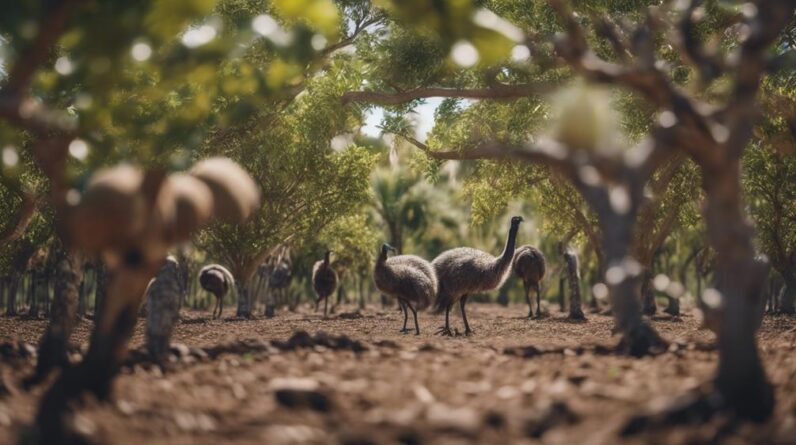
Ever thought your agroforestry system could use a touch of the exotic? Emus might just be the unexpected solution you've been looking for. These majestic birds offer a range of benefits that could revolutionize your farming practices.
From boosting soil fertility to providing natural pest control, integrating emus into your agroforestry system could be the missing piece you never knew you needed.
Curious to uncover how these unique creatures can transform your agricultural landscape?
Key Takeaways
- Emus enhance soil fertility, water retention, and nutrient cycling in agroforestry systems.
- Their presence promotes biodiversity, wildlife conservation, and ecosystem health.
- Emus aid in natural pest control, weed management, and soil enrichment without chemicals.
- Integrating emus supports water conservation, climate resilience, and economic benefits for farmers.
Increased Soil Fertility

By integrating emus into agroforestry systems, you can enhance soil fertility through their natural behaviors and interactions with the ecosystem. Emus play a crucial role in improving soil structure by their constant movement and scratching behavior. This action helps break up compacted soil, promoting better aeration and root growth. Additionally, emus' droppings are rich in nutrients, which contribute to enhancing soil fertility. The excreta act as a natural fertilizer, providing essential minerals and organic matter that enrich the soil and support plant growth.
Moreover, emus aid in water retention within the soil. Their scratching behavior not only improves soil structure but also helps to create small indentations on the ground. These indentations act as mini-reservoirs during rainfall, allowing water to infiltrate the soil instead of running off. This mechanism increases water retention capacity, reducing soil erosion and enhancing overall moisture levels in the agroforestry system. Emus, through their natural behaviors, play a vital role in maintaining soil health and promoting sustainable agriculture practices.
Natural Pest Control
Integrating emus into agroforestry systems offers a natural and effective approach to managing pests in a sustainable manner. Emus act as biological control agents, contributing to the regulation of pest populations through predator-prey dynamics.
Here are three key ways in which emus enhance natural pest control:
- Foraging Behavior: Emus have a keen sense of detecting pests in agroforestry systems, actively consuming insects and small rodents that can cause damage to crops. Their omnivorous diet allows them to target a wide range of pest species, reducing the need for chemical pesticides.
- Territorial Protection: Emus establish territories within the agroforestry system, patrolling and deterring pest animals from invading the area. This territorial behavior helps create a natural barrier against pest infestations, minimizing crop damage without the use of harmful chemicals.
- Dung Control: Emus help control pest populations indirectly through their dung. Their droppings contain compounds that repel certain insects, disrupting their breeding cycles and reducing pest numbers in the ecosystem. This biocontrol mechanism promotes a balanced predator-prey dynamic, fostering a healthier agroforestry environment.
Diverse Vegetation Management

Implementing a diverse vegetation management strategy is crucial for optimizing the ecological benefits of integrating emus into agroforestry systems. By carefully selecting and maintaining a variety of plant species within the agroforestry landscape, you can enhance wildlife conservation efforts and promote ecological balance. Diverse vegetation provides habitats for a wide range of beneficial organisms, including pollinators, predators of pest species, and native wildlife.
Agroforestry practices that incorporate diverse vegetation help create a more resilient and sustainable agricultural system. The presence of different plant species can improve soil health, water retention, and nutrient cycling, leading to increased productivity and long-term viability of the agroecosystem. Additionally, a varied vegetation structure can enhance biodiversity and ecosystem stability, contributing to overall environmental health.
Reduced Weed Pressure
To achieve reduced weed pressure within agroforestry systems, a strategic approach to vegetation management is essential. By integrating emus into these systems, you can effectively enhance weed suppression and promote soil enrichment. Emus play a crucial role in maintaining a balanced ecosystem by naturally controlling weed growth through their feeding habits.
Here are three key benefits of using emus to reduce weed pressure:
- Natural Weed Suppression: Emus have a selective diet, consuming a variety of weeds while avoiding desirable plants. This targeted grazing helps to keep weed populations in check without the need for herbicides.
- Mechanical Weed Control: Emus have a knack for trampling and disturbing the soil, which can destroy weed seedlings and prevent weed establishment. Their movement patterns create a natural weed management system.
- Nutrient Recycling: Emus deposit nutrient-rich feces throughout the agroforestry system, contributing to soil fertility and overall soil health. This process of soil enrichment aids in the competition against weeds, favoring the growth of desired vegetation.
Enhanced Biodiversity

Enhancing biodiversity within agroforestry systems involves fostering a diverse array of plant and animal species to promote ecosystem resilience and sustainability. By integrating emus into these systems, you can significantly increase habitat diversity, providing a range of niches for various species to thrive. Emus, with their grazing habits, help create a mosaic of habitats by altering vegetation structure and composition, which in turn attracts different wildlife species. This increased habitat complexity supports a greater variety of organisms, from insects to birds, contributing to enhanced biodiversity.
Furthermore, the presence of emus can aid in wildlife conservation efforts within agroforestry systems. Their foraging behavior can help control certain plant species, preventing them from becoming dominant and outcompeting native vegetation. This, in turn, supports the survival of native wildlife that rely on specific plants for food and shelter. Emus, therefore, play a crucial role in maintaining a balanced ecosystem that supports a wide range of species, promoting overall ecosystem health and resilience.
Improved Nutrient Cycling
Improved nutrient cycling efficiency can be achieved through the strategic integration of emus into agroforestry systems. These unique birds play a crucial role in enhancing soil health and providing nutrient-rich composting opportunities.
Here are three key ways in which emus contribute to improved nutrient cycling:
- Manure Distribution: Emus naturally spread their droppings across a wide area as they forage, effectively distributing nutrients throughout the agroforestry system.
- Nutrient Recycling: By consuming a diverse diet and efficiently digesting organic matter, emus recycle nutrients back into the soil in a form that's readily available for plant uptake.
- Enhanced Soil Aeration: Emus' constant movement and scratching behavior help loosen the soil, promoting better aeration and nutrient infiltration.
Integrating emus into agroforestry systems not only benefits the birds themselves but also creates a harmonious ecosystem where nutrient cycling is optimized, leading to healthier soils and more productive vegetation.
Sustainable Land Management

Sustainable land management practices encompass a range of strategies aimed at maintaining or enhancing the productivity and health of ecosystems over the long term.
In agroforestry systems, integrating emus can contribute significantly to sustainable land management. Emus help enhance carbon sequestration in soil through their foraging activities, which disturb the soil surface and stimulate plant growth, leading to increased organic matter decomposition and carbon storage. This process aids in mitigating climate change by capturing and storing atmospheric carbon in the soil.
Furthermore, emus can play a role in water conservation by reducing vegetation overgrowth, which in turn decreases water competition among plants and allows for more efficient water usage within the ecosystem. Their presence can also help prevent soil erosion by minimizing excessive plant growth that can destabilize the soil structure.
Climate Resilience
To bolster ecosystem resilience in the face of changing climates, the integration of emus into agroforestry systems presents a promising strategy. Emus, through their unique grazing habits, interact with vegetation differently than traditional livestock, offering a range of environmental benefits.
Here are three crucial ways emus enhance climate resilience in agroforestry systems:
- Livestock Integration: Emus can be integrated seamlessly into agroforestry systems, diversifying the animal component and reducing the environmental impact compared to conventional livestock.
- Emu Grazing: Emus contribute to maintaining a balanced ecosystem by selectively grazing on different plant species, promoting biodiversity and preventing overgrazing.
- Carbon Sequestration: The presence of emus in agroforestry systems stimulates the growth of vegetation, which in turn enhances carbon sequestration, aiding in the mitigation of greenhouse gas emissions.
These factors highlight the importance of considering emus as valuable additions to agroforestry systems when aiming to improve climate resilience and sustainability.
Economic Benefits for Farmers

Incorporating emus into agroforestry systems not only enhances climate resilience but also provides farmers with significant economic benefits. Emus offer a dual-purpose advantage by contributing to the ecological balance within the agroforestry system while generating increased income for farmers, thus promoting financial stability. One key economic benefit of integrating emus is their high reproduction rates and relatively low maintenance costs, resulting in a steady production of emu-related products that can be sold for profit. Additionally, emus are known for their efficient feed conversion, requiring less input compared to traditional livestock, further reducing expenses for farmers.
| Economic Benefits of Emus in Agroforestry Systems | ||
|---|---|---|
| Increased Income | Financial Stability | Efficient Feed Conversion |
| Diversification of Revenue Streams | Reduced Input Costs | Sustainable Profitability |
Lower Input Costs
Lowering input costs is a critical aspect to consider when integrating emus into agroforestry systems for improved economic efficiency. Emus can contribute to cost-effective solutions and sustainable practices within agroforestry systems. Here are three key benefits:
- Reduced Feed Costs: Emus are efficient converters of feed into body mass, requiring less feed compared to other livestock species. This efficiency contributes to lower feed expenses, making emus a cost-effective choice for farmers.
- Minimal Veterinary Expenses: Emus are generally healthy birds that require minimal veterinary interventions when raised in suitable environments. This leads to reduced veterinary costs, enhancing the overall economic viability of integrating emus into agroforestry systems.
- Natural Pest Control: Emus have a natural instinct for foraging and consuming a variety of insects and pests. By integrating emus into agroforestry systems, farmers can benefit from their pest control abilities, reducing the need for chemical pesticides and lowering associated costs.
Emus not only offer economic benefits but also support sustainable agricultural practices, making them a valuable addition to agroforestry systems.
Healthier Agroecosystems

Emus play a crucial role in fostering healthier agroecosystems through their natural behaviors and contributions to ecosystem balance. Their presence aids in wildlife conservation by creating microhabitats within agroforestry systems that support diverse flora and fauna. Emus help maintain ecological balance by controlling pests like insects and weeds through grazing activities, reducing the need for chemical interventions. Additionally, their foraging behavior stimulates soil aeration and nutrient cycling, enhancing soil health and promoting plant growth.
Integrating emus into agroforestry systems also contributes to livestock integration and farm sustainability. Emus can coexist with other livestock species, utilizing different foraging patterns to minimize competition for resources. This harmonious cohabitation not only maximizes land utilization but also reduces the environmental impact of farming practices. Emus' efficient conversion of feed into protein further supports farm sustainability by optimizing resource use.
Enhanced Overall Productivity
How can the presence of emus in agroforestry systems enhance overall productivity and efficiency? Emus play a crucial role in increasing profitability and ensuring environmental sustainability within agroforestry systems. Consider the following key benefits:
- Efficient Pest Control: Emus are natural foragers and consume a variety of insects and pests that can harm crops. By integrating emus into agroforestry systems, you can reduce the need for chemical pesticides, leading to healthier plants and increased yields.
- Nutrient Cycling: Emus produce nutrient-rich manure that can be utilized to fertilize the soil. This natural fertilizer enhances soil health, promotes plant growth, and ultimately boosts overall productivity.
- Weed Management: Emus have a unique feeding behavior that includes selective grazing. They can help control weed growth by targeting specific plants, reducing competition for resources and allowing desired crops to flourish.
Integrating emus into agroforestry systems not only enhances productivity but also contributes to a more sustainable agricultural approach, benefiting both the environment and your bottom line.
Frequently Asked Questions
Can Emus Be Integrated Into Agroforestry Systems in All Types of Climates and Regions?
In all climates and regions, emus can be integrated into agroforestry systems. Their adaptability and behavior make them suitable. Management strategies vary by region to optimize benefits. Emus contribute to sustainable practices and ecosystem health.
How Do Emus Interact With Other Livestock Species Within an Agroforestry System?
In agroforestry systems, emus exhibit intriguing inter species dynamics, influencing grazing behavior. They interact assertively with other livestock, showcasing territorial tendencies. Understanding these interactions can enhance overall system productivity and animal well-being.
What Specific Challenges May Arise When Integrating Emus Into Agroforestry Systems, and How Can They Be Addressed?
When integrating emus into agroforestry systems, challenges like emu behavior, climate suitability, and livestock interactions may arise. Addressing these requires understanding emus' needs, ensuring climate compatibility, and managing their interactions with other livestock species.
Are There Any Potential Negative Impacts of Integrating Emus Into Agroforestry Systems That Farmers Should Be Aware Of?
When integrating emus into agroforestry systems, potential challenges like habitat disruption and soil compaction may arise. Mitigation strategies include rotational grazing, monitoring soil health, and providing alternative habitats to minimize negative impacts on the ecosystem.
How Do the Benefits of Integrating Emus Into Agroforestry Systems Compare to Other Sustainable Agriculture Practices?
Delving into the realm of sustainable practices, comparing Emus in agriculture to other methods reveals diverse benefits. Climate suitability, livestock interactions, and negative impacts awareness are focal points. Embrace these insights for informed decisions.
Conclusion
In conclusion, integrating emus into agroforestry systems offers a multitude of benefits that can significantly improve soil fertility, pest control, vegetation management, and overall productivity.
By reducing weed pressure, enhancing biodiversity, and lowering input costs, farmers can create healthier agroecosystems that lead to economic benefits.
Emus truly bring a breath of fresh air to the agricultural landscape, turning it into a flourishing oasis of opportunity and sustainability.





